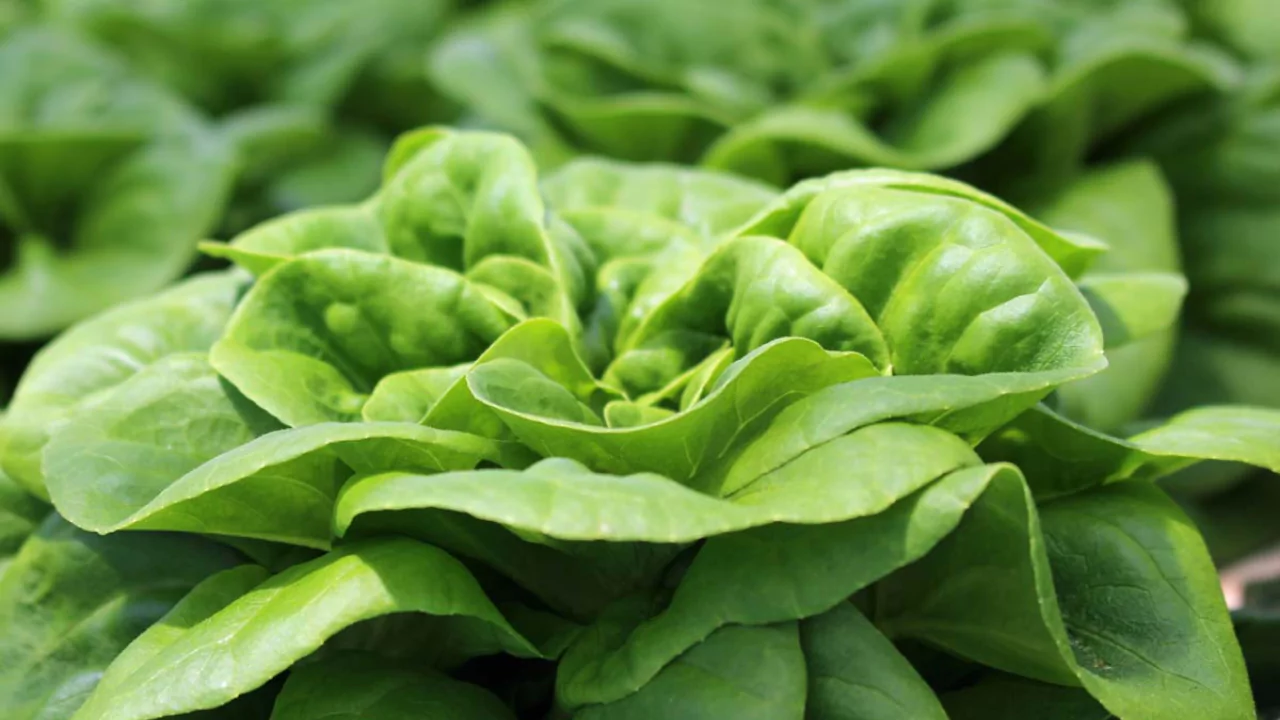
Butter lettuce belongs to the butterhead group of lettuces that also includes Boston and Bibb types. Though it traces its roots back to the Mediterranean, most contemporary butter lettuce is cultivated in the United States, where farmers favored the older Silesia strain first recorded in 1744.
Heads of butter lettuce tend to be relatively large, bright green, and distinguished by loose, pliable leaves that feel almost creamy to the touch. Those leaves are remarkably tender and carry a mild, slightly sweet taste, making the variety an excellent choice for sandwiches, salads, or quick wraps.
Nutritionally, butter lettuce breaks the stereotype that greens offer little beyond water and roughage. It delivers impressive amounts of calcium, magnesium, potassium, and vitamins A, C, and K, so regular inclusion supports overall health.
To gauge freshness and flavor strength, gently scratch the stem and inhale; a pronounced sweet fragrance usually signals pleasant sweetness, while a dry, bitter smell foreshadows leaves that may unpleasantly surprise diners.
Growing Conditions for Butter / Bibb Lettuce
Butter lettuce, like most leafy greens, prefers cool air, so it thrives in the moderate temperatures of spring and autumn. In regions with mild summers, growers can also squeeze in a crop during early or late summer. Although the plants benefit from full sun, sustained heat can cause them to wilt or shoot up seed stems.
Butterheads flourish in soil that drains well, feels loose to the touch, and stays cool around the roots. Aim for a pH between 6.2 and 6.8; lettuce grows poorly in overly acidic or basic ground. Adding plenty of compost or well-rotted matter also sharpens the sweet, tender flavor the leaves are known for.
How to Plant Butter Lettuce
You can either start butter-lettuce seeds indoors under lights or press them directly into moist soil outside. For an indoor start, plant the seeds about one inch deep in cell trays three to four weeks before you intend to transplant.
When you move the seedlings outdoors, space them six to ten inches apart within rows that are twelve to eighteen inches distant. This gives each plant room to spread its leaves without competing for moisture or nutrients.
To sow butter lettuce outdoors, wait until early spring when the soil is workable. Plant each seed no more than one-eighth inch deep and space them about one inch apart. Keep the rows twelve to eighteen inches apart to allow room for growing heads.
Care of Butter Lettuce
During germination, keep the soil evenly moist. A light watering daily-slowly reducing to every second day after sprouting-will suffice. Consistent moisture encourages tender, sweet leaves.
Because the roots stay near the surface, a thin layer of mulch conserves moisture and curbs weeds. Weed gently or use hand tools to spare the delicate roots. Floating row covers can guard young plants against hungry insects.
Garden Pests and Diseases of Butter Lettuce
Butter lettuce attracts a long list of pests, so scout the patch regularly. Watch for aphids, armyworms, corn earworms, crickets, darkling beetles, flea beetles, garden symphylans, grasshoppers, leaf miners, nematodes, snails, slugs, thrips, vegetable weevils, and whiteflies. Prompt identification and treatment protect both yield and flavor.
You can protect plants from pests-or deal with an existing outbreak-by lifting the pests off by hand, bringing in beneficial insects, or whipping up a simple homemade spray.
Lettuce can still fall victim to a long list of diseases, including black root rot, downy mildew, bacterial spot, soft rot, Anthracnose, Rhizoctonia, gray mold, Sclerotinia rot, lettuce necrotic yellows virus, spotted wilt, and lettuce mosaic virus.
In many instances, keeping the soil well-drained limits conditions that let those diseases take hold.
Harvesting Butter Lettuce
Butter lettuce takes roughly sixty to seventy days from sowing to reach full maturity. If seed stalks begin to rise, pick the heads right away. For a clean cut, slice the stem about an inch above the soil.
Try to lift the heads during the cool morning hours so they droop less. You may also harvest microgreens, baby greens, or leaves from mature heads.
For microgreens, trim the whole plant two weeks after sowing-once it reaches three to four inches. Hand-picking baby greens is easiest between twenty-eight and thirty-five days post-germination.
After that, pluck mature leaves by hand until the plant bolts.
Butter Lettuce Varieties to Grow in Your Home Garden
Two main types of butter lettuce, Bibb and Boston, thrive equally well in the backyard garden.
- Bibb: lettuce takes its name from John Bibb, a gardener who first grew the strain in the 1850s. Its leaves are wider and paler than those of most other butter lettuces.
- Boston: butter lettuce probably appeared on American farms during the 1920s. Modern Boston types can show reddish pigments, with colors that range from thin streaks to nearly solid mahogany edges.
Want to Learn More about Growing Butter Lettuce?
To dig deeper into raising this gentle green, watch RedHat Cooperatives short video on hydroponic production. That soil-less technique lets you keep whole heads in the refrigerator for almost three weeks.